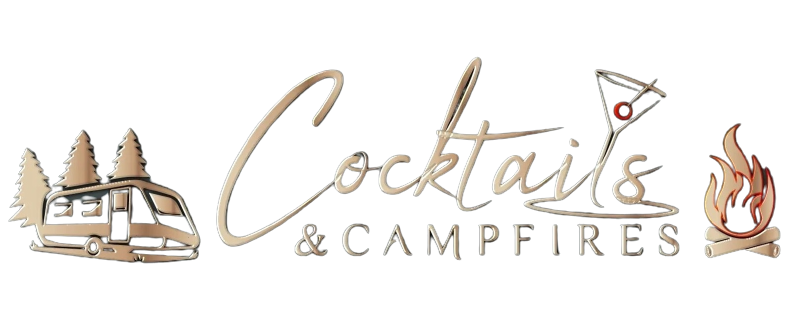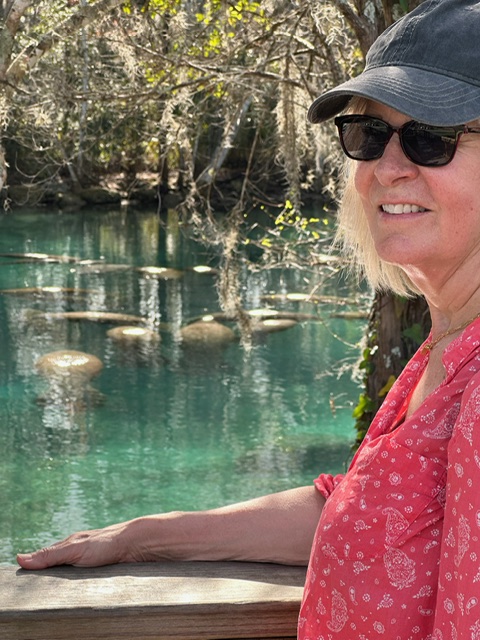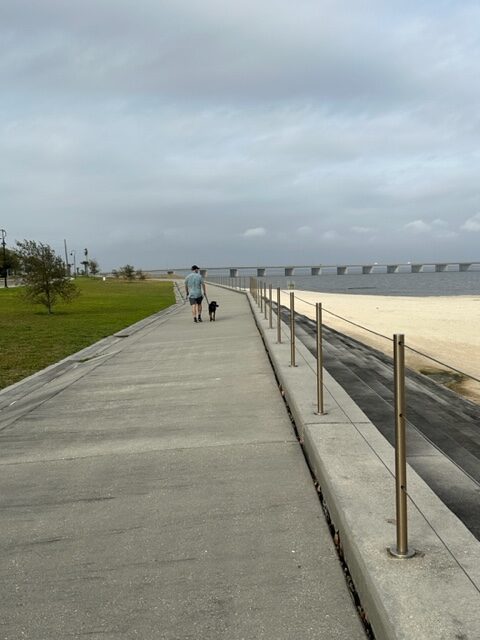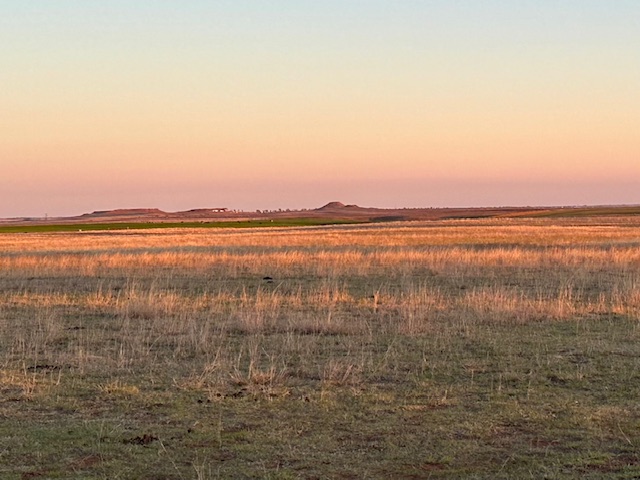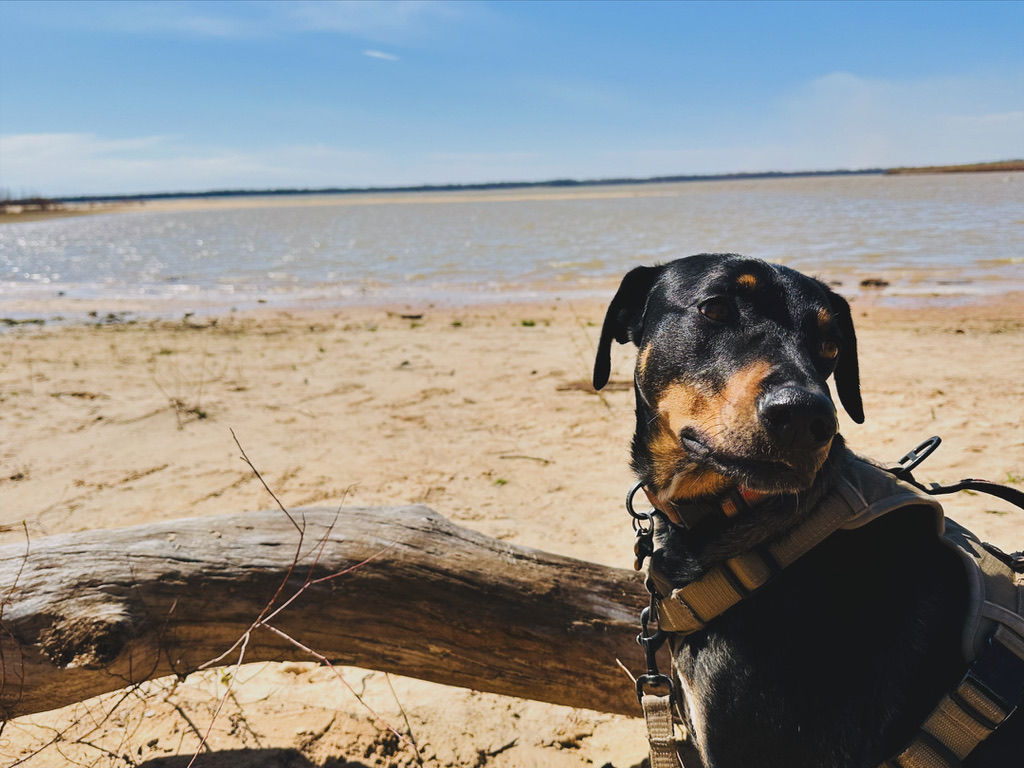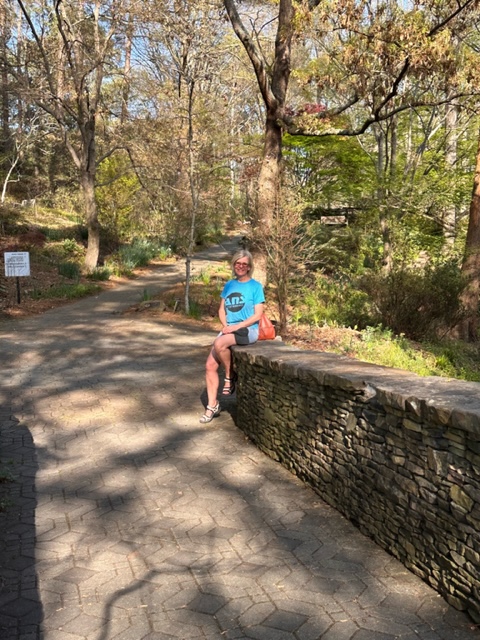Eustis to Crystal River – 20 January 2024
Crystal River is on the West coast of Florida, bordering on the Gulf of Mexico. It is home to thousands of Manatees, who shelter here in the warm springs during Winter time.
I loved everything about this area including our campground – Crystal Isles, Crystal River, which is a Thousand Trails resort that had been recently hit first by a Hurricane and then shortly afterwards a Tornado, so the campground was still in a state of repair. Having said that, they had obviously been doing repairs for a while and the place was already looking great. We had a fabulous site backing onto a lake – of course full of alligators, but during our time they were nowhere to be found. This campground attracted a lot of very large RVs, most of which looked like they were set up for the entire winter season with complete outside kitchens and enclosed patios. Within the park you could hear the sounds of many different birds and we would often be visited by Anhingas and White Ibis as well as the crow like Boat tailed Grackle. There was a very nice pool and hot tub that we were able to make use of and also a very active Pickleball club. We didn’t join their 9am games but did practice late one afternoon. We are still very much Pickleball novices, so we want to practice a little more before joining in games with other people. We also had to go out and buy some Pickleball shoes as neither Derek nor I had anything suitable for playing on a court. The road leading to the campground had marked bike lanes on either side so I was able to dust off my bicycle and go for a ride, but mainly I used the bike lanes to take Jax for walks in the morning. There was always something to see along the way.
The day after we arrived we drove to Dunnellon and did an 8km hike, first along the Blue Run trail and then onto the connector to the Withlacoochee State trail. Alongside the trail was the Withlacoochee river which eventually empties into the Gulf of Mexico. The surface of the water in certain parts of the trail was covered in brown seeds and with the Cyprus “knees” sticking out, looked very much like a dirt path. In the past this area was used to mine Phosphate and there were several large mounds of soil still evident. There was also a restored historic bridge and railway pilings, all reminders of the industrial purposes the river once had. The town of Dunnellon bills itself as “Treasure of the Nature Coast” because it is a paddler’s dream.
Another interesting walk near to our campground was along part of the Florida Birding trail which is a network of more than 500 premier wildlife viewing sites across the state. It was a little cooler that day and we didn’t see many birds but we did see several Mullet jumping out of the water. It seems there is no definitive explanation for the jumping – some say it is to escape predators and others say they do it during the spawning season to break open their egg sacks, in preparation for the spawn. It could also be to clear their gills and fill them with oxygen. The number of jumps they make is correlated with the concentration of oxygen in the water. The less oxygen, the more jumps. Mullets play an important role in keeping water clean by feeding on decaying leaves and algae. Unfortunately for them, they have many predators (other fish, turtles, snakes, alligators and humans.) They are the only fish that have a gizzard which they use to grind up and digest plant material and they can tolerate a wide range of water salinities from full saltwater to fresh.
While walking along the trail we couldn’t help admiring all the Palm trees, their trunks artistically pleasing with the bases of their dead fronds forming intricate patterns. There are over 2500 species of Palm tree and they come in all shapes and sizes, from small shrubs to towering trees. Some palms can reach heights of 69 ft or much more. The Palm tree is a remarkably sturdy tree. Its strong trunk and fronds can flex and bend during extreme weather conditions without breaking making it able to withstand strong hurricane winds. We were therefore surprised to find that a number of dead trunks lying on the ground were completely hollow. Not all Palm trees have hollow trunks but some like the Sabal Palm do. The air filled hollow trunk gives the tree additional support and helps to reduce the amount of water they lose through transpiration. The hollow trunk also has the benefit of providing a safe habitat for various animals, such as birds, bats, and even squirrels.
A couple of days later we went to visit the Three Sisters Springs, a world renowned winter sanctuary for the West Indian Manatee. There are 3 main springs and about 20 spring vents within the refuge. The springs create a beautiful, pristine aquamarine oasis and a winter refuge for Manatees, who are sensitive to cold water temperatures, providing a constant flow of 23 degrees c water. Manatees are very passive, slow moving creatures, moving at a relaxing speed of about 5mph. Despite being a sea creature, the leathery skinned Manatee’s closest relative is the elephant. They have a large, flexible, upper lip, which is used to gather food, eat and communicate. They also have a short snout. Despite being 9-10ft long and 1000-3500 lbs, Manatees are surprisingly agile and can swim vertically, upside down, barrel roll, and even do somersaults. While their brains are small, they have been shown to perform as well as dolphins when given specific tasks. Manatees have voracious appetites and can consume 10-15% of their body weight each day, rightfully earning their ‘sea cow’ nickname. As they are herbivores, these calories typically come from various underwater grasses.
I always enjoyed the mornings in the campsite as it was an opportunity to study the birds around the lake. The one morning we were visited by some White Ibis, who were walking around the outside of the RV. Ibis are very distinguishable by their long curved beaks. The tip of their beak is very sensitive so they can sense prey as they probe the mud, and their nostrils are at the base of their beak so they can breathe while probing. There are 29 varieties of Ibis found in warm wetlands all over the world. They come in many different colours even bright red. Ibis are gregarious birds that live, travel and breed in flocks. Amazingly they can travel up to 70 km a day in V formation. The mascot of the University of Miami in Florida is a White Ibis, affectionately called Sebastian the Ibis. They chose the White Ibis for its heroic ability to withstand hurricanes, which is the name of the university’s football team (Miami Hurricanes.)
After a couple of days of catching up with work, I researched dog friendly hikes in the area and found the Pepper trail which runs along the outskirts of the Ellie Schiller Homosassa Springs Wildlife Park. It was a pleasant walk along a road lined with dense Palm trees and other vegetation. As we got back to the parking lot we passed a flower beds that had some unusual cones that were split open revealing bright orange seeds. The seeds were from a Coontie Palm which in spite of its name, is not a palm but Florida’s only native Cycad dating back to pre historic times. This extremely hardy plant reaches a mature height of 4 ft and is popular for landscaping. In late winter, both male and female plants produce a rusty brown, cone shaped fruit. The male cones are thinner and shorter than the female cones, and produce pollen. Female cones are upright, brown, 6 inch tall and covered in a velvety fuzz. Upon maturity, the female cones open to reveal the bright orange lobed seeds. The Coontie Palm is the preferred food source for larvae of the rare Atala butterfly. The larvae absorb the natural toxic ‘cycasin’ found in the plant and use it to repel birds and other predators. This same chemical that is so beneficial to the Atala is very toxic to many animals and humans. The Coontie Palm is known by many names including cardboard palm, sago tree, and sago palm, to name a few. Life expectancy of this plant is well beyond 100 years.
We were keen to return to the Wildlife Park without Jax which we did the following day. It was a fabulous place filled with many native Florida birds, as well as snakes, a bear, alligators, deer and manatees. We saw Lu the Hippo basking in the sun, as well as a very large Alligator lying on the grass and another one with just his head sticking out of some green water – like a log. After passing many cages with birds, we arrived at the Pelican enclosure where there was a chaotic splashing in the water as they competed for food being thrown by one of the staff from a bridge above their river. We saw a number of both white and brown Pelicans. What was fascinating was the tumour like bony structure on the white Pelican’s beak. Apparently both sexes grow this bony “wart” (called a caruncle) during the breeding season and once the season is over, it falls off.
The brown Pelicans are one of only two birds that dive dramatically into water to fish. It will fly up as high as 100 ft before folding back its wings and plunging straight down into the water. I would have loved to video one in action. They have a large gular pouch which is a thick layer of skin located on the lower mandible and connected to the throat. It is used both to scoop their food but also to cool down which they do by rapidly flapping their gular pouch, called a gular flutter, while their bill is open. One of the Pelicans had only half a wing on one side and did a lopsided jump down to the water. It seemed okay once it was floating.
There were also a few Black crowned Night Herons observing the feeding frenzy. One of them perched on the railing of the lookout bridge and I was able to take some close up photos of it. This is a very social bird that will hang out with other species. An interesting fact about them is that they will brood any chick that is placed in their nest. They apparently don’t distinguish between their own offspring and those from other parents.
Across from the Pelican enclosure was a solitary Bear. He had his head against the wire watching the birds, not doubt eyeing them out for supper. Eventually he gave up and started playing on the grass. He kept on grabbing his back leg in his teeth and then rolling over on his back. It would have been so nice if he had, had a companion to play with but he certainly was making up for it and a joy to watch.
There were also a number of Flamingoes referred to a “Flamboyance” of Flamingos with beautiful, vibrant colours. I learned that the baby chicks are called Flaminglets (sounds like a brand of chewing gum.) BOTH parents feed their babies “Crop” milk which they produce from the upper part of their digestive tract.
Flamingoes eat with their heads upside down. They have brush like plates along the edge of their bill which pumps water out while catching food inside – 20x a second! To be able to eat upside down they have a large lower bill and a smaller upper bill. Opposite to all other birds. And of course, which I did know, their colour comes from the food they eat, however, a white Flamingo means it’s feeding young.
Apart from the above mentioned birds, we also saw a number of different Owls, Osprey, Eagles, Herons, Cranes, Egrets and Vultures. There were also a couple of Foxes and Cougars. On the Reptile front, there was a special enclosure with snakes and turtles. One of the snakes, a King Snakes, was particularly curious of everyone and came right up to the glass. The King snake is one of several varieties of snake common to Florida. He was extremely active which was great as most of the other snakes kept themselves quite hidden. Surprisingly enough, while we have been on a number of hikes around Florida we have as yet to see any type of snake in the wild, in spite of signs everywhere warning of snakes. Having said that I hope I’m not temping fate! The King snake gets its name from its habit of eating other snakes including venomous snakes (immune to their venom) as well as its own species. Not only do they slither across the ground, they are also excellent tree climbers and swimmers. They are usually about 3 to 5ft in length but can grown 6 ft +.
This park rehabilitates Manatees and there was a large tank with injured Manatees and also several in the Homosassa spring but as the day was rather hot most of them were further out in the water. A great park which did not have the feeling of a zoo as a lot of the enclosures were quite open and of course a lot of the animals were here to be rehabilitated.
The most memorable experience during our time at Crystal River was when we swam with the Manatees. We especially bought a waterproof iphone case so we could take videos and photos and Derek was designated photographer. We tried the case out in the pool at the campground and it worked great. “Snorkeling with the Manatees” was organized by a local dive shop – Fun 2 Dive. They provided the wet suits, snorkels and pool noodles for buoyancy and took us out in their boat to the Three Sisters Springs. They stayed with us in the water at all times and also took photos which we could buy from them later $$$. Swimming from the outside channel into the springs was pretty tough as we were fighting against a strong current. Once we were in the spring it was very calm and visibility high in the crystal clear blue waters, so we could easily observe the Manatees swimming below us in the water. The Manatees were huge and as a result a little intimidating, but in spite of their enormous size, I had to keep reminding myself they are very gentle creatures, and will not harm humans. The good thing is that they are well protected by law, and we were not allowed to touch them and had to keep our legs and feet high so they had clear passage to swim by. We had just experienced a few days of hot weather so there weren’t as many Manatees in the spring as we had seen when we previously visited the refuge, but that was fine by me. The highlight of the day was seeing a large Manatee rolling over onto its back as it played in the water and also a mother and its baby. After about an hour and a half in the water I started to get the shakes and was very cold and it was time to return back to the boat for hot chocolate.
During our time in Crystal River Derek used the opportunity to do some maintenance on the RV while I was working. After completing the repacking of the wheel bearings on the RV, he lifted the tire 5cm to align with the wheel studs and when he removed his top hand, the wheel slid off the studs and fell to the ground only supported by his left hand at the bottom. This hyper extended his left forearm and he heard a tear in the lower forearm and elbow. It took several weeks to heal but fortunately there was no damage to the joint. Luckily he could still drive, albeit with only one arm.
On the 29th January we were told of the tragic death of our friend David Strubin’s twin brother, Pascal. Pascal had been diagnosed with a brain tumour only months prior. Unfortunately during surgery it was found to be highly malignant and could not be completely removed. David and his family had to watch him gradually slip away from them over the months. This was naturally an extremely, heart wrenching and difficult time for David and whereas we tried to do whatever we could to support him, from afar during this time we were painfully aware of the negative impact of our travels at time like these, when you are needed most by those you love.
